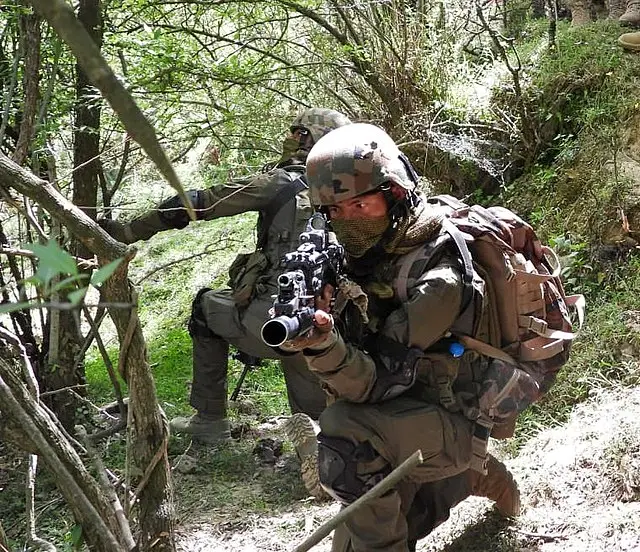Jammu and Kashmir: Three Terrorists Trapped as Encounter Underway in Udhampur District

On Wednesday, April 9, 2025, security forces engaged in an encounter with terrorists in Udhampur district, Jammu and Kashmir, after establishing contact with a group. This operation follows several events that began over two weeks ago in neighboring Kathua district. The Udhampur encounter is part of a broader operation that has involved tracking terrorists’ movements across different areas.
The Udhampur Encounter
The encounter took place in the village of Jopher, within the Ramnagar police station area of Udhampur. According to the Udhampur Police, security forces initiated the operation during a search conducted by local police and paramilitary forces. Upon establishing contact with the terrorists in Jopher, firefights quickly broke out. The forces confirmed that at least two to three terrorists are trapped in the area, and the operation is ongoing.
Security personnel from Jammu and Kashmir Police, the Indian Army, and other paramilitary forces are actively involved in the operation. DIG of Udhampur-Reasi Range, Rayees Mohammad Bhat, confirmed that the encounter continues, with ongoing firing in Marta village, Ramnagar. Authorities are awaiting more information, but heightened security and vigilance have already been established in the region.
This encounter forms part of a larger, ongoing operation that has stretched over several weeks. Multiple encounters since late March have seen security forces relentlessly tracking and neutralizing terrorist cells in Jammu, especially after high-profile attacks.
The Larger Operation: A Timeline of Events
The operation in Udhampur and surrounding areas began on March 24, 2025, when security forces in Kathua district initiated a search after receiving intelligence about terrorist activities. The operation quickly escalated into multiple encounters, with security forces engaging in firefights with the terrorists as they moved between locations.
On March 27, a major encounter took place in the Sanyial area of Kathua, where security forces killed at least two terrorists, though tragically, four policemen also lost their lives. This loss highlighted the severe challenges faced by the forces, who continue to battle insurgents in Jammu and Kashmir.
The operation expanded across several regions, with security forces tracking the terrorists as they sought to evade capture. As the terrorists attempted to relocate, the police and military maintained strict surveillance, determined to apprehend or eliminate them.
The Role of Intelligence and Surveillance
Intelligence gathering and surveillance have played a crucial role in the operation’s success. Authorities have leveraged both human and technical intelligence sources to track the terrorists’ movements with precision. Drones, satellite imagery, and coordination between local and national agencies have been pivotal in identifying terrorists’ hideouts and preventing their escape.
Modern technology has significantly enhanced counterinsurgency operations, allowing forces to monitor suspects in real-time. This capability has enabled them to respond swiftly to emerging threats, minimizing collateral damage and civilian casualties.
Furthermore, the Jammu and Kashmir Police, alongside the Army and paramilitary forces, have demonstrated exceptional coordination, ensuring that the operation remains efficient and responsive to the dynamic nature of the situation.
Security Challenges in Jammu and Kashmir
The events unfolding in Udhampur and Kathua underscore the persistent security challenges in Jammu and Kashmir. For years, the region has been a hotspot for insurgency, with various terrorist groups operating across the area. While the situation has improved in recent years, militancy remains a significant threat, exacerbated by cross-border terrorism and local insurgent groups.
Terrorists operating in the region often target both security forces and civilians in an effort to destabilize the area. In response, the security forces continually adapt to new tactics, including dealing with improvised explosive devices (IEDs), ambushes, and the use of urban areas for concealment. These factors make counterinsurgency operations particularly challenging.
The mountainous terrain further complicates security operations. The dense forests and rugged landscapes of Jammu and Kashmir provide terrorists with ideal hiding spots, making it difficult for security forces to track them effectively.
The Impact on Local Communities
While the security forces work to neutralize the threat, the encounters have had a significant impact on local communities. Residents of Udhampur and surrounding areas often find themselves caught in the crossfire between the militants and security personnel. Although efforts are made to minimize civilian casualties, the presence of active encounters disrupts daily life, leading to evacuations, school closures, and roadblocks.
Moreover, these repeated encounters take a psychological toll on local populations. The constant threat of violence creates a climate of fear, affecting the mental health of both adults and children. To mitigate these effects, local authorities and NGOs provide counseling and support to those displaced or traumatized by the conflict.
Conclusion: Ongoing Efforts and Vigilance
As the encounter in Udhampur continues, security forces remain vigilant and committed to neutralizing the threat posed by the terrorists. The ongoing operation reflects the determination of the Jammu and Kashmir Police, the Indian Army, and other security agencies to combat militancy and restore peace in the region.
The outcome of this operation will likely influence the security situation in Jammu and Kashmir in the coming weeks. However, tackling terrorism in the region remains a significant challenge, and it is clear that the fight between security forces and militants will continue to shape the conflict in Jammu and Kashmir for the foreseeable future.






